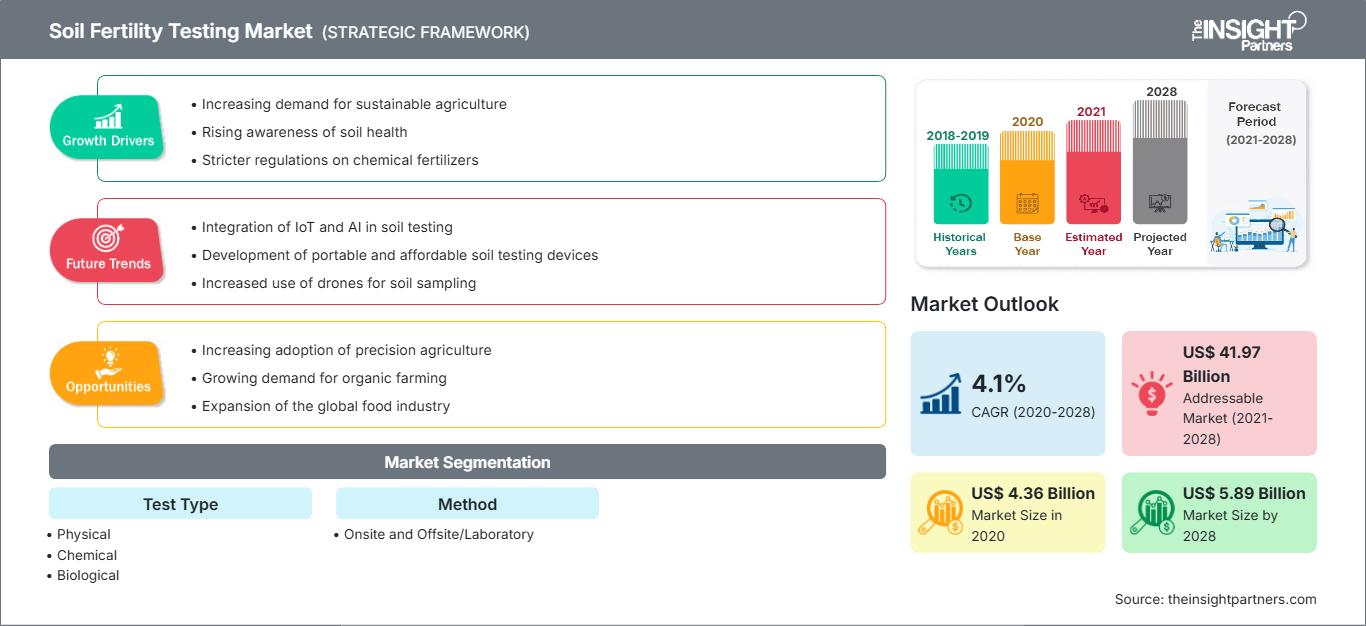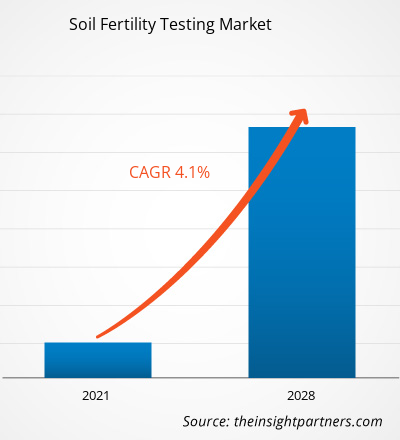The soil fertility testing market was valued at US$ 4,355.51 million in 2020 and is projected to reach US$ 5,891.06 million by 2028; it is expected to grow at a CAGR of 4.1% from 2021 to 2028.
Soil fertility testing helps determine the growth potential of soil, indicating inadequacies of nutrients, potential toxicity caused by excessive fertility, and inhibitions due to non-essential trace minerals. The testing results can also be used to determine the need of simulating roots’ abilities to assimilate minerals.
The soil fertility testing market in Asia Pacific is expected to grow at the highest CAGR during the forecast period. The projected growth of the market in this region is mainly attributed to the rise in demand for high-quality farm products and ingredients, and rapid advancements in agricultural practices in China and India. Japan is another significant contributor in the growth of soil fertility testing market in the region.
Customize This Report To Suit Your Requirement
You will get customization on any report - free of charge - including parts of this report, or country-level analysis, Excel Data pack, as well as avail great offers and discounts for start-ups & universities
Soil Fertility Testing Market: Strategic Insights

-
Get Top Key Market Trends of this report.This FREE sample will include data analysis, ranging from market trends to estimates and forecasts.
Impact of COVID-19 Pandemic on Soil Fertility Testing Market
The COVID-19 outbreak has disrupting the soil fertility testing market due to the slowdown of agricultural activities, instabilities in supply chains, limitations on trade movements, and decrease in the availability of workforce, among others. The outbreak has distorted operational efficiencies and disrupted the value chains due to the sudden shutdown of national and international boundaries. However, as the economies are planning to revive their operations, the demand for soil fertility testing is expected to rise globally in the coming months. Furthermore, the demand for healthy food crops, fruits, and vegetables as well as the need for nutrient-rich and immunity-boosting food products have risen due to an increase in number of COVID-19 cases, which would support the soil fertility testing market growth. Further, amid the pandemic, agrarian nations such as India, Bangladesh, and Vietnam, where agriculture accounts for 12–16% of GDP, have been hit the worst. Despite relief plans and packages announced by governments for small farmers, the agriculture sector performance has been declining. The supply of agricultural produce from California, which supplies nearly one-third of the US’s fruits and vegetables, was restricted with the surge in infection in 2020, which hampered the growth of the soil fertility testing market in the country.
Market Insights
Stringent Government Regulations Pertaining to the Nutrient Content of Crops Boost Fuel Soil Fertility Testing Market Growth
The application of fertilizers, especially the synthetic ones, leads to liberation of harmful gases into the atmosphere, which harms the environment. As a result, various countries have imposed several rules to prohibit the emission of such harmful gases into the atmosphere. For instance, the Food and Drug Administration (FDA) regulates domestic and imported food products that are marketed in interstate commerce; it ensures the safety, hygiene, nutritional content, wholesomeness of food as well as the appropriateness of product labels. In addition, the Agricultural Operations Regulation (2002) aims to address the problem of diffuse pollution caused by agricultural activities by ensuring the effective balance of phosphorus in the soil to preserve soil fertility and reduce losses from excessive manure application. The regulation also encompasses standards for livestock structure and manure management as well as land-use regulations to limit water pollution. Further, in countries such as the US, Canada, Australia, and European Union, there is strong emphasis on the framework of monitoring policies and their strict enforcement to achieve greater supply chain transparency as well as too ensure traceability. Such actions ensure that infected food, feed, and agricultural products are rejected at borders treated appropriately before passing them for further domestic distribution. Violators are charged steep fines or/and their licenses are withdrawn. Therefore, to meet the safety and quality requirements set by various regulatory agencies, agricultural yield testing is increasingly being used as a preventive measure.
Soil fertility testing provides information about soil health and proper nutrition required by crops, as well as information on chemicals applied to soil and their effects on the same. Soil contamination is projected to have a detrimental impact on the native ecology, including plants and humans. Toxic substances in the soil can degrade soil fertility and diminish soil yield. If such soils are utilized to grow fruits and vegetables, the yield would lack critical nutrients and may contain dangerous compounds that can cause major health concerns. Moreover, at the time of export, crop nutritional values must be checked as they should meet the requirements set by various governments. Soil fertility testing is carried out to avoid such consequences. Therefore, the stringent government regulations pertaining to the nutrient content of food products stimulates the soil fertility testing market growth.
Test Type Insights
Based on test type, the soil fertility testing market is segmented into physical, chemical, and biological. The chemical segment accounted for the largest market share in 2020 and is expected to register the highest CAGR in the market during the forecast period. Chemical soil tests have emerged as a monitoring tool for avoiding excessive nutrient input to the farm system. These tests help determine the concentration of essential plant nutrients such as phosphorus, nitrogen, potassium, available lime, organic matter, sulfur, and trace elements as well as other physical properties such as capacity, permeability, density, and pH. Further, the soil chemical testing assists in the optimization of crop production, protection of the environment from contamination caused by runoff and leaching of excess fertilizers, diagnosis of plant culture problems, and enhancement of nutritional balance of the growing media.
Method Insights
Based on method, the soil fertility testing market is segmented into onsite and offsite/ laboratory. The offsite/laboratory segment accounted for a larger market share in 2020 and is expected to register a higher CAGR in the market during the forecast period. The offsite method of soil testing includes organic matter levels, microscopy, organism activities, fumigation, and molecular method. In laboratories, atomic absorption spectrophotometers, inductively coupled plasma spectrometers (ICPs), lachat flow injection analyzers, colorimeters, and other laboratory equipment are used to examine soil fertility. Laboratory methods for soil fertility testing provide knowledge about the state and management of soil, management of soil fertility, need to reduce spending on fertilizers, and ways of avoiding over-fertilization and preventing soil deterioration.
A few of the key players operating in the soil fertility testing market are SGS SA; Eurofins Scientific; ALS Limited; Agrolab GmbH; Actlabs; Agrocares; Water Agriculture Laboratories, Inc.; Polytest Laboratories; Crop Nutrition Laboratory Services Ltd.; and A and L Great Lakes. The key companies implement the mergers and acquisitions, and research and development strategies to expand customer base and gain significant share in the global market, which also allows them to maintain their brand name globally.
Soil Fertility Testing Market Regional InsightsThe regional trends and factors influencing the Soil Fertility Testing Market throughout the forecast period have been thoroughly explained by the analysts at The Insight Partners. This section also discusses Soil Fertility Testing Market segments and geography across North America, Europe, Asia Pacific, Middle East and Africa, and South and Central America.
Soil Fertility Testing Market Report Scope
| Report Attribute | Details |
|---|---|
| Market size in 2020 | US$ 4.36 Billion |
| Market Size by 2028 | US$ 5.89 Billion |
| Global CAGR (2020 - 2028) | 4.1% |
| Historical Data | 2018-2019 |
| Forecast period | 2021-2028 |
| Segments Covered |
By Test Type
|
| Regions and Countries Covered |
North America
|
| Market leaders and key company profiles |
|
Soil Fertility Testing Market Players Density: Understanding Its Impact on Business Dynamics
The Soil Fertility Testing Market is growing rapidly, driven by increasing end-user demand due to factors such as evolving consumer preferences, technological advancements, and greater awareness of the product's benefits. As demand rises, businesses are expanding their offerings, innovating to meet consumer needs, and capitalizing on emerging trends, which further fuels market growth.

- Get the Soil Fertility Testing Market top key players overview
Report Spotlights
- Progressive industry trends in the soil fertility testing market to help players develop effective long-term strategies
- Business growth strategies adopted by companies to secure growth in developed and developing markets
- Quantitative analysis of the soil fertility testing market from 2019 to 2028
- Estimation of global demand for soil fertility testing
- PEST analysis to illustrate the efficacy of buyers and suppliers operating in the industry
- Recent developments to understand the competitive market scenario
- Market trends and outlook as well as factors driving and restraining the growth of the soil fertility testing market
- Assistance in decision-making process by highlighting market strategies that underpin commercial interest, leading to the market growth
- Size of the soil fertility testing market at various nodes
- Detailed overview and segmentation of the market, as well as the soil fertility testing industry dynamics
- Size of the soil fertility testing market in various regions with promising growth opportunities
Soil Fertility Testing Market – by Test Type
- Physical
- Chemical
- Biological
Soil Fertility Testing Market – by Method
- Onsite
- Offsite/Laboratory
Company Profiles
- SGS SA
- Eurofins Scientific
- ALS Limited
- Agrolab GMBH
- Actlabs
- Agrocares
- Waters Agricultural Laboratories Inc
- Polytest Laboratories
- Crop Nutrition Laboratory Services Ltd.
- A and L Great Lakes
Frequently Asked Questions
Based on test type, why is the chemical segment expected to grow at the highest rate during 2021–2028?
Can you list some of the major players operating in the Global Soil Fertility Testing Market?
What is the scope of soil fertility testing in the global market?
- Historical Analysis (2 Years), Base Year, Forecast (7 Years) with CAGR
- PEST and SWOT Analysis
- Market Size Value / Volume - Global, Regional, Country
- Industry and Competitive Landscape
- Excel Dataset
Recent Reports
Related Reports
Testimonials
Reason to Buy
- Informed Decision-Making
- Understanding Market Dynamics
- Competitive Analysis
- Identifying Emerging Markets
- Customer Insights
- Market Forecasts
- Risk Mitigation
- Boosting Operational Efficiency
- Strategic Planning
- Investment Justification
- Tracking Industry Innovations
- Aligning with Regulatory Trends





















 Get Free Sample For
Get Free Sample For